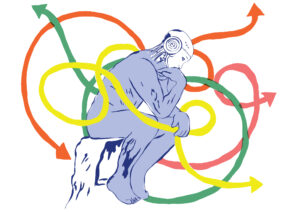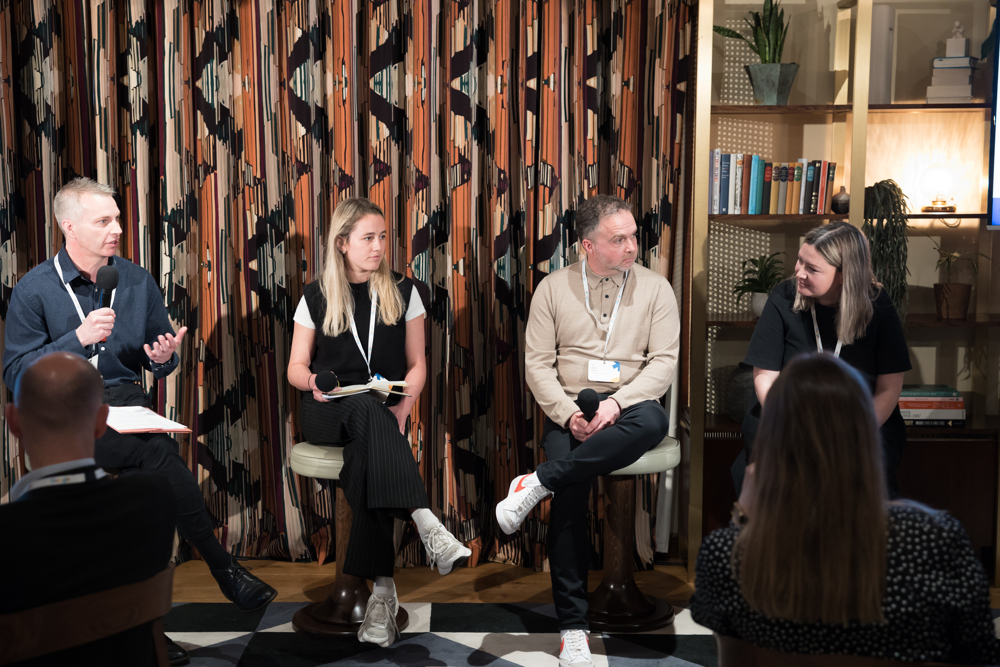

I recently had the pleasure, and honor, of speaking at Google’s local news event on a panel alongside Daisy Donald and Jeremy Clifford of FT Strategies, and Steve Barron, of Highlands News and Media. One of the biggest challenges brought up was the question of advertising vs subscription for digital monetization. My argument: let’s stop talking about advertising vs subscription, it’s advertising AND subscription that will support sustainability for local news publishers.
To get the full picture of reader revenue trends and prioritizations for digital publishers, it’s important to look back over the past few years…
2022 was the year of retaining these subscribers.
As for 2023, the focus is on diversification as we’ve realized how any revenue stream can be put at risk at any moment with the cost-of-living crisis, increasing competition amongst subscription brands, tightening privacy regulations and the end of 3rd party cookies.
Of course, both advertising and subscriptions are considered as important revenue streams for digital publishers. But they’re often considered as dichotomous – you either have an ad-based revenue or subscription-based model.
But what if you can employ both?
And how?
One word: registration
The act of converting anonymous users into known, logged, free members.
If you’ve been following The Audiencers closely, you might have noticed that I’m a big fan of registration. Of course, we’re all aware by now of the value of registration for a subscription model as a way of increasing propensity to subscribe. But what’s often forgotten is the reason why this is the case… engagement.
Logged users are highly more engaged than anonymous readers – they come back more frequently, consume more content, stay for longer and interact with your site thanks to the features they now have access to as a member, such as being able to read more articles, save content for later and share their opinion through commenting.
Tool tip: build registration as a product, just like subscription, with a value proposition, key benefits and an onboarding journey that aims to increase engagement. For instance: encourage newsletter sign up, app download and introduce new members to their account space so they make the most of the value you offer. Find more registration best practices here.
> You’ll also enjoy: How Alternatives Economiques’ registration model increases LTV
Use registration to learn about how to engage your audience
Thanks to de-anonymization and gaining a single-customer view, registration also gives you valuable insights into your audience behavior and the strategies that are most effective for encouraging a value exchange and increasing engagement.
A great example of a publisher maximizing on this strategy is Blick in Switzerland, who now has 647,000 logged members, and counting, acquired through a diverse acquisition strategy:
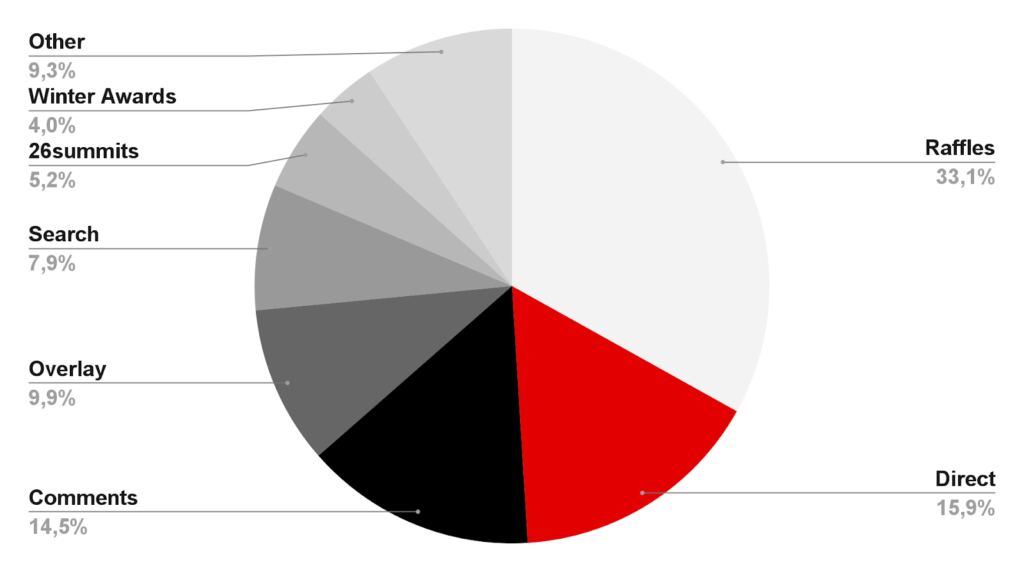
Thanks to this model, they’ve been able to increase frequency, recency and volume of visits, as well as better understand what makes their users partake in a value exchange.
For example, although commenting has been a valuable acquisition channel (14.5% of their members registered this way), the vast majority of these members are male, despite Blick’s overall audience being very balanced male-female. Raffles, however, which account for 33.1% member aqcuisition, appear to engage and attract both genders, so the publishers has been putting more energy and focus into this conversion strategy over others.
Registration for revenue diversification
Importantly, both subscription and advertising monetization are an outcome of customer engagement, meaning registration supports revenue diversification.
Subscription:
- Registered users are highly more likely to subscribe: 13 times more at L’Équipe and 45 times at The Independent
- They also have higher retention rates meaning a greater CLTV than your average subscriber
Advertising:
- Thanks to the first-party data and custom reader IDs, ad spots can be sold at a higher cost (targeted to a specific profile), and higher engagement means more eyes on more pages
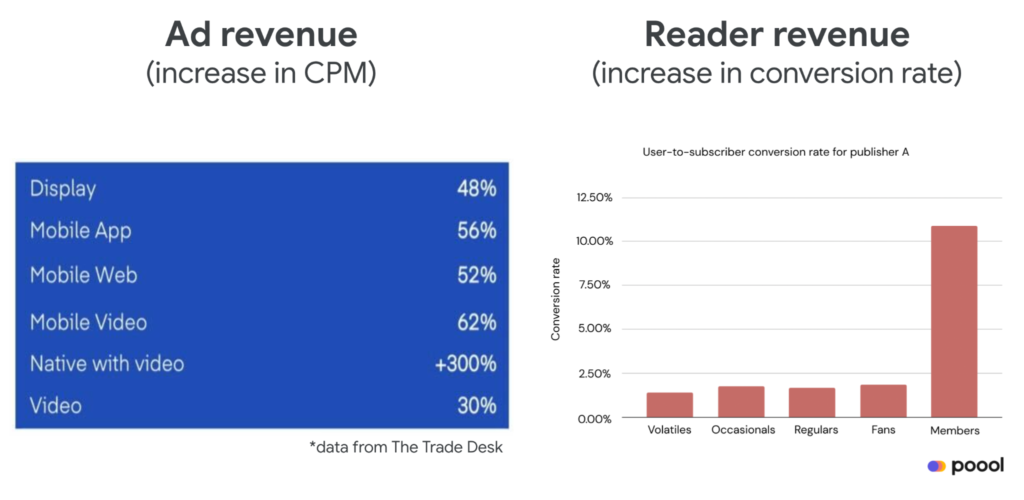
But whilst registration provides a valuable solution to balancing these two revenue streams, there’s a lot more at play given that many of the features of ad-based models aren’t synonymous with a high-value premium offer and a reader-first model. For instance:
- Instead of content being purely for generating traffic and bringing eyeballs on-page, articles in a reader-first model should be curated to reinforce loyalty and engagement, aiming to increase recency, frequency and volume of visits
- Engagement and life-time value metrics should be prioritized over clicks and page views, something that the whole company needs to buy into. This article on the best engagement metrics for a reader revenue model will be useful here
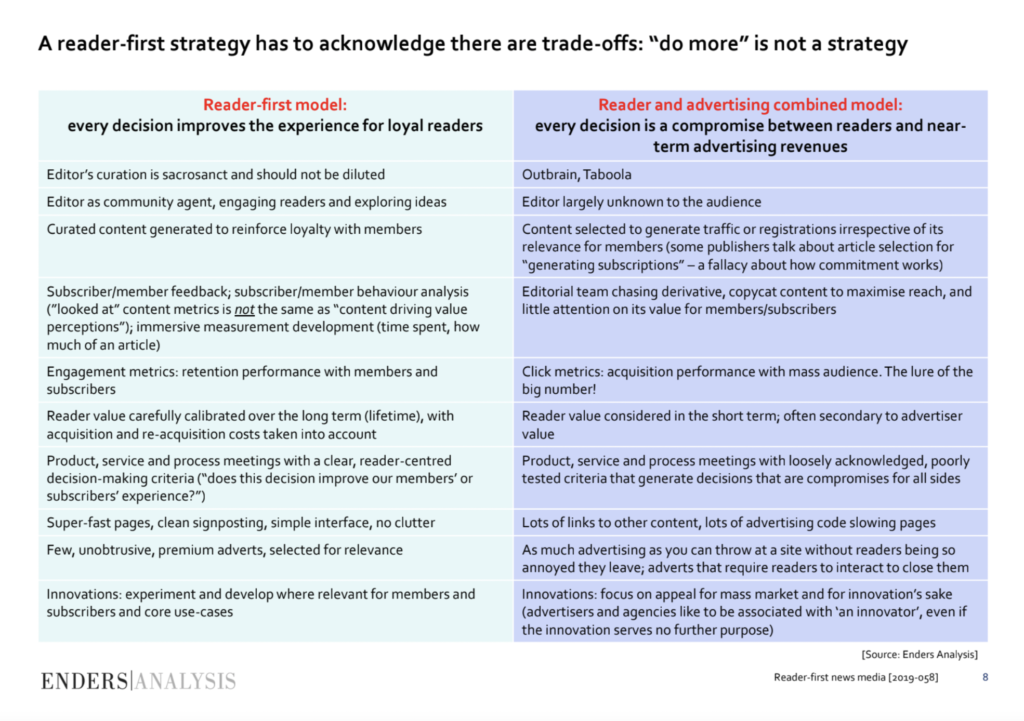
Not all users are created equal
The other important point to consider when it comes to diversification is dynamicity – adapting your strategy to the individual reader.
We’ve all heard about how large publishers such as The New York Times or Washington Post employ complex, machine-learnt dynamic paywalls, but dynamicity is far from something exclusively for these large media.
The whole idea of being dynamic is that you maximize the value of each individual visitor, whether they subscribe or not.
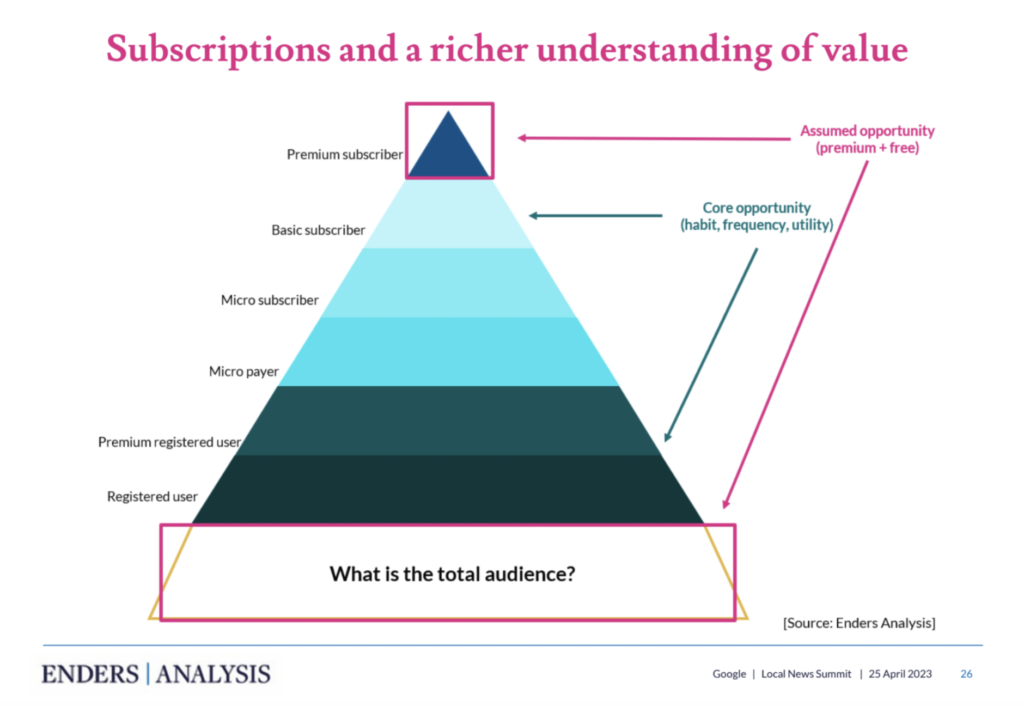
Douglas McCabe at Enders Analysis discussed the very same, sharing this diagram showing the core opportunity being in between the anonymous user and a premium subscriber.
For instance, whilst your fan readers who visit your site on a daily basis are likely to respond positively to a paywall and convert into a subscriber, volatile users who only visit once a month will probably turn around, leave your site and find content elsewhere. Of course, if they do that, you won’t be able to monetize them in even a minimal way (e.g. from advertising). Instead, you can consider targeting these less engaged users with a soft conversion journey to increase engagement and LTV, such as by offering a free article before encouraging them to sign up to your newsletter or create a free account (where you can collect additional ad revenue and data points to inform your strategy).
You can then work on personalized experiences to more effectively convert them into a subscriber.
For example, say you have a handful of newsletters, each with a specific theme. You may not have machine-learning technology, but you do know that subscribers to each of these newsletters are interested in a specific topic. So, what ELLE Magazine did was to create a UTM_source to place in the URL links in their newsletter so that subscribers to each newsletter would see a paywall adapted to this interest.
For users signed up to the fashion newsletter, the paywall copy fore-fronted the subscription benefits that a fashion-lover would appreciate. Whilst those receiving the relationships newsletter would see different copy, adapted to this specific interest.
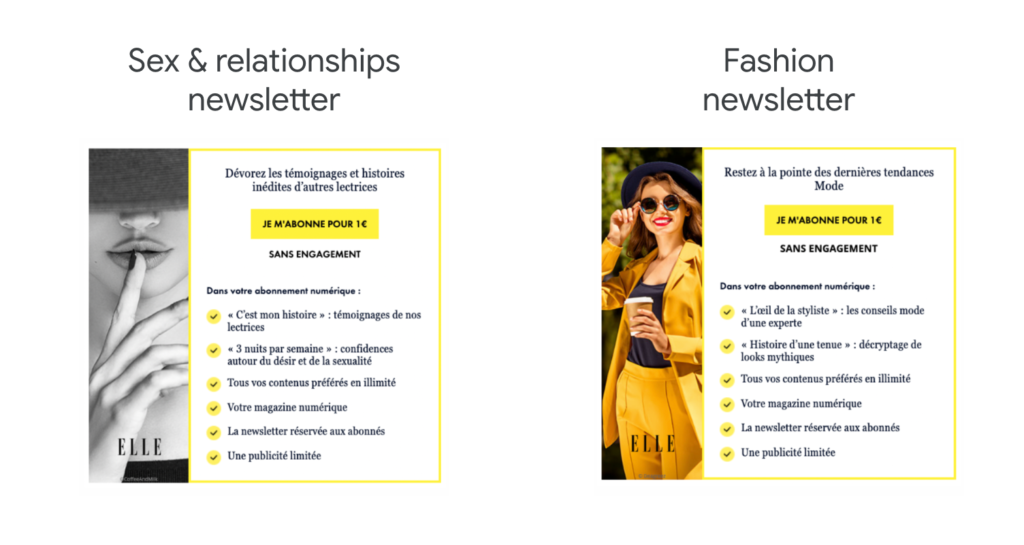
> You’ll also enjoy: How the fashion magazine ELLE is using a dynamic paywall to optimize conversion rates
The personalization possibilities are endless…
How can the wall adapt?
- The design: colors, images, photos of journalists, format (banner, box or pop-up)
- The offers (annual vs monthly pricing, discounted offer, number of offers on the wall…)
- The wording (value proposition, personalization to the person or the content-type…)
What could the wall adapt to?
The reader’s context or profile:
- The content type – is this wall on an article talking about general news or politics? E.g. the content is telling you key information about the reader’s interests, so use this to your advantage in writing an adapted value proposition
Le Figaro adapts the paywall messaging based on the content type:

- The source of traffic – did this user come from a newsletter, social media, a partner…? E.g. users coming from a news aggregation site may not yet be aware of the value you offer. So, you could consider leading them through an adapted soft engagement journey, just like Journal du Dimanche did with upday
- The reader’s location, e.g. The Guardian’s personalized messaging says “you’re joining us from France”






